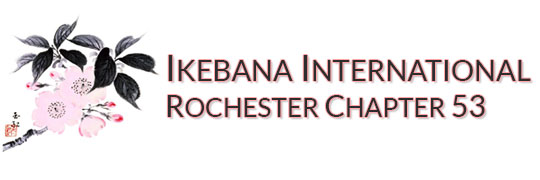
In the Ichiyo School of Ikebana, being a modern school, students are taught to be able to make arrangements for all sorts of areas. These arrangements may be little for small areas in one’s home, or they may be large arrangements for open areas such as museums, conference areas, or stages. These larger arrangements are called “taisaku” arrangements which is a Japanese terms for “large work or arrangement.”
The arrangements that you will be seeing in this post were made by Ms. Valerie Eccleston. She lives in the Washington, DC area and has been studying and creating ikebana since the 1970’s. She received her Master’s certificate in 1992, and in 2006 she was appointed President of the Washington, DC Chapter of the Ichiyo School by the late Iemoto Akirio Kasuya. In 2009, she was appointed by him to the rank of Executive Master.

The arrangement next to this text is large enough to be on the floor, but not all taisaku arrangements need to be on the floor. What is typical of the Ichiyo School of Ikebana is the use of natural materials. We don’t often use unnatural materials due to this emphasis. There is some unnatural materials used in this arrangement as seen in the clear plastic container, and black grid, and rope at the top of the bamboo. However, the emphasis is on the natural materials.
Another characteristic of the Ichiyo School of Ikebana is the use of bamboo. In this arrangement, the bamboo was split in the middle with only the ends being intact. The rope helps keep the ends from splitting.
In this last arrangement, the viewer can again see the use of the clear square plastic containers. But also, the viewer can see the black metal containers. Also there is the different types of branches being used. Some of them are live branches, but also included is the large white branch with the black areas created by the use of the black rope wound around the branch. These black rope areas on the white branch tie in with the similar black metal containers.

In the Ichiyo School of Ikebana natural dried branches are used as they are found in nature. But also sometimes, they may be spray painted or even be wrapped with paper. Some of the paper used to cover the branches may be very bright in color.
In the next posts, I’ll show arrangements on the other end of the size spectrum. Until then, enjoy seeing these large “taisaku” arrangements. They have a lot to offer the viewer–like many small arrangements put together for a unified whole.
